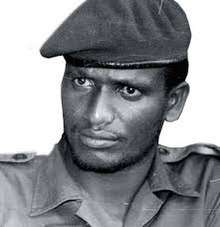Fred Rwigyema
Fred Gisa Rwigema (also spelled Rwigyema; born Emmanuel Gisa; 10 April 1957 – 2 October 1990) was a Rwandan politician and military officer. He was the founder of the Rwandan Patriotic Front (RPF), a political and military force formed by Rwandan Tutsi exile descendants of those forced to leave the country after the 1959 Hutu Revolution.
Fred Gisa Rwigyema | |
|---|---|
 | |
| Personal details | |
| Born | April 10, 1957 Gitarama, Rwanda |
| Died | October 2, 1990 (aged 32) Nyabwenshogozi Hill, Rwanda |
| Military service | |
| Allegiance |
|
| Years of service | 1976-1990 |
| Rank | Major General |
| Battles/wars | |
Rise in Uganda
Rwigema was born in Gitarama, in the south of Rwanda. Considered a Tutsi, in 1960 he and his family fled to Uganda and settled in a refugee camp in Nshungerezi, Ankole following the Hutu Revolution of 1959 and the ouster of King Kigeli V.[1]
After finishing high school in 1976, he went to Tanzania and joined the Front for National Salvation (FRONASA), a rebel group headed by Yoweri Museveni, the brother of his friend Salim Saleh. It was at this point that he began calling himself Fred Rwigema. Later that year, he traveled to Mozambique and joined the FRELIMO rebels who were fighting for the liberation of Mozambique from Portugal's colonial power.
In 1979, he joined the Uganda National Liberation Army (UNLA), which together with Tanzanian armed forces captured Kampala in April 1979 and sent Idi Amin into exile.[2]
He later joined Museveni's National Resistance Army (NRA), which fought a guerrilla war called the Ugandan Bush War against the government of Milton Obote. It was here that Rwigyema first fought alongside a number of future RPF leaders including future Rwandan president Paul Kagame, Patrick Karegeya, and Kayumba Nyamwasa.[3]
After the NRA captured state power in 1986, Rwigema became the deputy Minister of Defence. He was regularly at the front line in northern Uganda during the new government's offensives against remnants of the ousted regime.
Invasion of Rwanda and death
On 1 October 1990, Rwigyema led the a splinter group of 10,000 NRA troops in an invasion of northern Rwanda.[4] What became the RPF chose this date as it was close to Ugandan independence day on 9 October.[3] This served as an excuse for Rwigyema, as the movement could be disguised from the main NRA as a military parade.[3]
On just the second day of the struggle, Rwigyema was shot in the head and died at Nyabwenshogozi Hill[5] His death was kept secret for a month so as not to harm morale.[6] There is a dispute about the exact circumstances of Rwigyema's death; the official line of Kagame's government, and the version mentioned by historian Gérard Prunier in his 1995 book on the subject, was that Rwigyema was killed by a stray bullet.[7][8] In his later book, however, Prunier states that he had established "from incontrovertible evidence (including an interview with an eyewitness to the killing)" that Rwigyema was killed by his subcommander Peter Bayingana, following an argument over tactics, and excused his readers for having accepted the "cooked version of facts [the RPF] provided" him with.[9]
Prunier speculates that Kagame manipulated Bayingana and another commander named Chris Bunyenyezi into killing Rwigyema.[10] The theory, which he says is shared by former RPF members, is that Rwigyema came from a rival clan from Kagame, and that Kagame wanted to eliminate a possible future national leader.[10] Rwigyema was replaced as president by Kagame who eventually led the RPF to victory in July 1994.
Rwigyema is considered one of Rwanda's national heroes. His body was buried at the Heroes Cemetery in Kigali.
Notes
- "Gen Fred Rwigyemas untold story". www.newvision.co.ug. Retrieved 2019-04-13.
- "Today in history: RPA invades Rwanda". New Vision. 1 October 2019. Retrieved 2 October 2019.
- Waugh, Colin M., 1955- (2004). Paul Kagame and Rwanda : power, genocide and the Rwandan Patriotic Front. Jefferson, N.C.: McFarland & Co., Publishers. ISBN 0786419415. OCLC 56058176.CS1 maint: multiple names: authors list (link)
- Suhrke, Astri. (1999). The Path of a Genocide : the Rwanda Crisis from Uganda to Zaire. Adelman, Howard. Somerset: Taylor and Francis. ISBN 9781351477673. OCLC 993780868.
- "Was Rwigyema assassinated?". Daily Monitor. Retrieved 2019-04-13.
- "Death of Maj Gen Rwigyema". Daily Monitor. Retrieved 2019-04-13.
- Government of Rwanda (2009). "Chronology of Events Leading to Liberation". Official Website of the Government of Rwanda. Archived from the original on 2012-03-07. Retrieved 2013-05-09.CS1 maint: ref=harv (link)
- Prunier 1999, pp. 95–96.
- Prunier 2009, pp. 13–14, note 50 for "cooked version of facts". For "incontrovertible evidence", see p. 355.
- Prunier, Gérard (31 December 2008). Africa's world war : Congo, the Rwandan genocide, and the making of a continental catastrophe. Oxford. ISBN 9780199705832. OCLC 1091901440.
References
- Prunier, Gérard (1999). The Rwanda Crisis: History of a Genocide (2nd ed.). Kampala: Fountain Publishers Limited. ISBN 978-9970-02-089-8.CS1 maint: ref=harv (link)
- Prunier, Gérard (2009). Africa's World War : Congo, the Rwandan Genocide, and the Making of a Continental Catastrophe: Congo, the Rwandan Genocide, and the Making of a Continental Catastrophe. Oxford: Oxford University Press. ISBN 978-0-19-970583-2.CS1 maint: ref=harv (link)